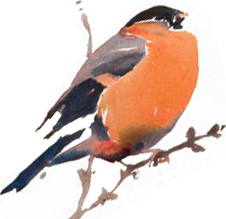How the season was going to unfold this year following the avian flu outbreak was unknown but, right on time, the birds returned late March. Over the next few weeks, the surviving pairs reunited, their abandoned territories reclaimed with impressive nest building and sheer joy (for observers) as the first eggs were spotted late April!
There is still a nervous trepidation as daily checks using the Scottish Seabird Centre webcams are undertaken. We knew the dynamics of the colony would change dramatically. Swathing gaps are quite visible even from the shore, but they also bring immense opportunities to observe the rebuilding of the colony.
Solo birds that have lost a partner hold their territories, but not without challenges from new single birds moving in, all looking to find partners. As with any new pairing, success is not guaranteed. Observations on fringe areas suggest It takes several years for new pairs to bond and settle. With such a fragmented colony, there are no defined fringe areas, no defined breeding areas, no club areas, and for the first time in five or six years, immature birds have space to explore the colony. It's heart-warming to see 3 to 4 weeks old down-covered chicks yipping away to newly hatched wobbly squabs, being attentively brooded. For the surviving breeders, it is looking very positive!
Having looked into that steely blue eye of the Gannet for many years, it is a little odd to see birds with black eyes, or one black and one normal, look back at you. Research is showing that they contracted the virus and have antibodies, which is wonderful. The iris has changed colour but their vison is unaffected. They may have changed eye colour, but I recognise the bolshie aggressive individuals that are back on their territories, which is a joy to see and hear. The decibel levels of previous years have reduced, the air space a little quieter, but with thousands of birds now returned, it is still a magnificent spectacle and really brings home just how fragile and how precious our seabird colonies are.

Breeding Herring Gulls are also back on form. With more gaps on the rock, they swoop in on the colony in hope of creating a melee for an easy meal. Only a handful of gull chicks survived last year but they too are looking good, with very protective adults that I am convinced have some form of precision laser training when they swoop and deposit their droppings, always managing to hit exposed skin even when wearing a hat!
It’s been interesting to see how the vegetation has flourished. For the first time in many years, Campion is growing down the rock face in the gully, and plans are afoot for a flora survey to be carried out in the near future.
How many birds are there?
The all-important question asked by many. The count for the Bass has always represented AOS (Apparently Occupied Sites by a pair) and it has essentially been full. Will a drone or a flyover differentiate between a solo bird holding a territory, or a breeder whose partner is off foraging, or a prospecting wandering bird that’s just dropped in? The weather and temperature does affect numbers. On hot windless days, the gaps are more obvious. It will take several years for the colony to settle, and that will reflect on the figures. It’s so important to begin to decipher this new page of the Bass Gannets. From the heartbreak and devastation of last year to the uplifting joyful scenes this year - but monitoring continues.
Maggie Sheddan
Scottish Seabird Centre
Photos: Bass Rock © Laurie Campbell; Gannet with black eye, Bass Rock, April 2023 © Maggie Sheddan




